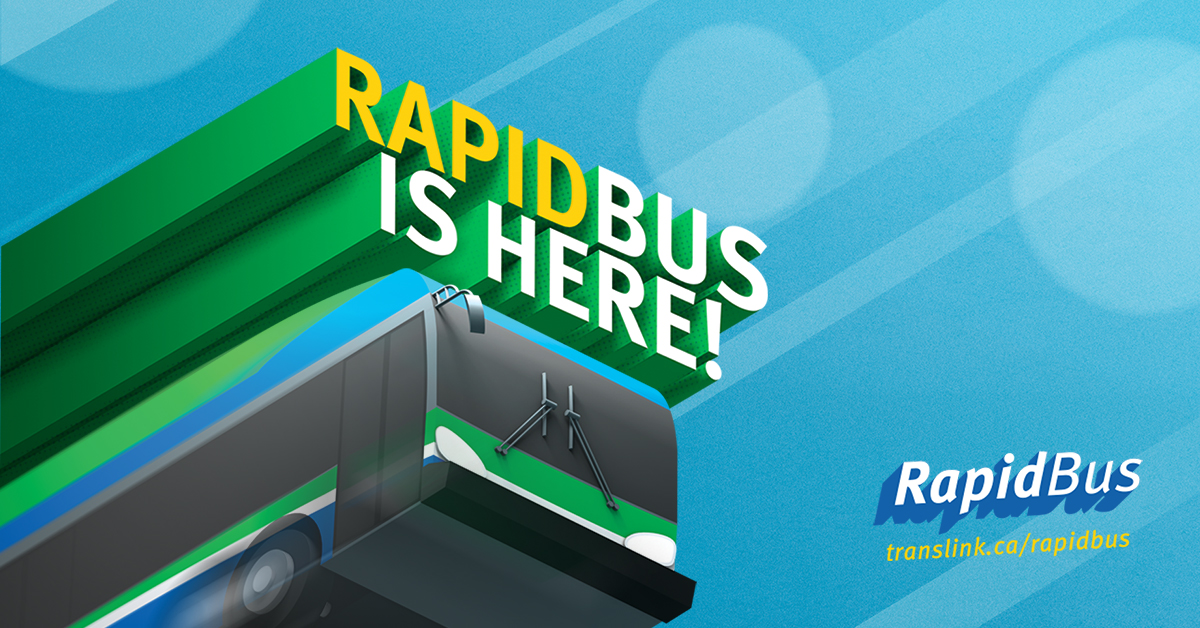TransLink launches new RapidBus service
TransLink launches new RapidBus service

TransLink launches RapidBus on four routes – bringing customers up to 20 per cent faster bus service with higher frequencies, fewer stops, dedicated bus lanes, bus priority changes to intersections, and all-door boarding.
RapidBus provides a more reliable bus service that can move more than 10,000 people per hour at peak times. The new service is made possible through investments from Phase One of the Mayors’ Vision, the Government of Canada, and the Province of BC.
“We’re stepping up our bus game,” says TransLink CEO Kevin Desmond. “RapidBus is a crucial part of improving the region’s bus service through the Mayors’ Vision. These RapidBus routes will benefit eight communities and bring our customers a more reliable bus service that they deserve.”
Coming every 10 minutes or better during peak hours and every 15 minutes or better in non-peak hours, customers can now catch a RapidBus on these four routes:
- R1 King George Blvd – (Guildford Exchange/Newton Exchange)
- Every eight minutes during peak hours
- R3 Lougheed Hwy (Coquitlam Central Station/Haney Place)
- Every ten minutes during peak hours
- R4 41st Ave (UBC/Joyce-Collingwood Station)
- Every three to six minutes during peak hours
- R5 Hastings St (SFU/Burrard Station)
- Every four to five minutes during peak hours
RapidBus customers will enjoy new customer amenities such as softer seats, more space on 60-foot articulated buses, real-time digital signage, and audio next-bus information at RapidBus stops.
RapidBus is the newest service added to improve the Metro Vancouver bus system. Here is a brief history of buses in Metro Vancouver:
| The evolution of Metro Vancouver transit buses | Year |
| RapidBus service launches | 2020 |
| First double-decker bus | 2019 |
| First battery-electric bus | 2019 |
| B-Line service begins | 1996 |
| First 60-foot articulated bus | 1991 |
| First lift-equipped buses | 1990 |
| HandyDART service launches | 1981 |
| SeaBus service launches | 1977 |
| First trolleybus | 1948 |
| Buses added to streetcar fleet | 1920s |
| Metro Vancouver streetcar service | 1890 |
The R2 Marine Drive route between Phibbs Exchange and Park Royal will enter service in spring of this year. There are seven more RapidBus routes planned for Phases Two and Three of the Mayors’ Vision following the launch of R2.
Rapid facts:
- 330,000 people live within walking distance of the four RapidBus corridors
- There are 98 new RapidBus stops installed along the four corridors
- All other routes that also use either Lougheed Highway or 41st Avenue will see faster service thanks to bus-priority road changes
- The R1 King George Blvd (previously the 96 B-Line) capacity is increasing 20 per cent
- The R5 Hastings St (previously the 95 B-Line) capacity is increasing 25 per cent
- The “B-Line” moniker is being retired (Except for Vancouver’s 99 B-Line, which will continue serving customers during the construction of the Broadway Subway)






As usuall you dont know or dont want to know the history from 1973 to1976
When we had FastBUS
e.g. 933 Lougheed FastBus 980 Barnet etc. Also express buses from Richmond Burnaby NW
etc.
Are there any more details on the RapidBus routes to be added in phase 2 (Scott Road, Richmond to Expo Line)?
Good to see TransLink is offering faster transit services. UBC has the population equivalent to the city of Nanaimo. It only makes sense to connect the sky train there rather than only to Arbutus.
R2 Marine Drive route?
HOW ABOUT R2 Bowinn Line?
I believe lift-equipped buses actually began service with the introduction of the GMC Classic coaches, around 1984/85, coinciding with the launch of Skytrain in 1986. And I, too, remember the FastBus service of the 70s.
Also, in the 1970s/80s, it took about the same amount of time to travel by bus from Downtown Richmond (Richmond-Brighouse Stn. today) to Seymour & Granville (Van City Centre Stn. today). ancouver!
Excited to see TransLink investing in improving its bus service.